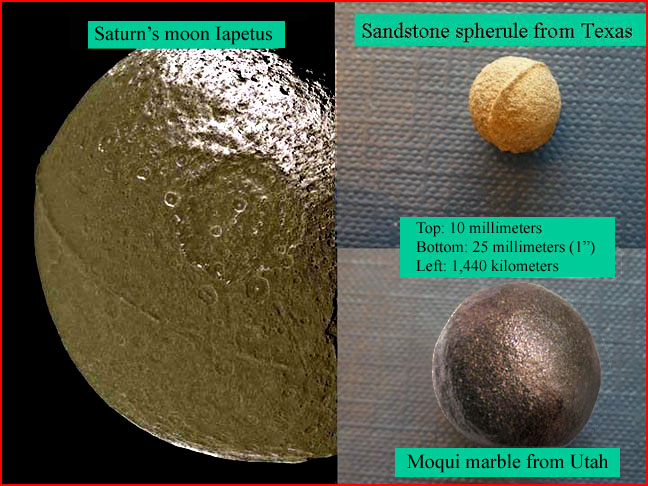
home •
about •
essential guide •
picture of the day •
thunderblogs •
news •
multimedia •
predictions •
products •
get involved •
contact
picture of the day archive subject index
Credit (left): NASA/JPL/Space Science Institute
Credit (upper right): C.J. Ransom
Credit (lower right): Mel Acheson
Aug 24, 2006
Equatorial Ridge of IapetusThe distinctive ridge around Saturn’s moon Iapetus bears an eerie similarity to equatorial ridges around concretions on Earth. In electrical terms, the similarity could be more than coincidence.
Traditional thinking in the sciences would not recognize a significant pattern above, though the three objects reveal an odd similarity. Each sphere possesses an equatorial ridge. But surely the two objects on the right could tell us nothing about the origins of the object on the left!
Astronomers assure us that Saturn’s moon Iapetus arose from the “circumstellar cloud” that gave birth to the Sun, planets, moons, and all of the lesser objects of the solar system. The critical event was the “gravitational collapse” of the primordial cloud billions of years ago. Since that event, little has changed in the make-up or in the celestial mechanics of the solar system.
Iapetus is a puzzle, however. The pronounced ridge around its equator has no place in the theory of gravitationally collapsing clouds.
Both objects on the right are called “concretions”, and their origins are also puzzling. The sandstone concretion (upper image) was found on a farm near the Red River in Texas, and the hematite Moqui marble was found in Utah (lower image). Concretions occur in abundance on our planet and have produced many speculations about their origins.
Certainly, in a gravity-only universe, there is no way to relate Iapetus to the formative processes of concretions. In size, the two are separated by up to eight orders of magnitude. Gravity is strong enough to form a sphere from a collection of matter the size of Iapetus, but there’s a lower limit to gravity’s ability to produce spherical shapes. (Asteroids and comet nuclei are below that limit and therefore seldom spherical.) And while geologists have hypothesized, but never demonstrated, the processes that form concretions, they have never suggested that such processes could give birth to Iapetus!
In the Electric Universe similarities across vastly different scales are to be expected. Plasma discharge structures do not change with increased size. A microscopic discharge in a lab plasma will have analogs on a galactic scale.
Plasma discharges create spheres. As noted in previous Pictures of the Day, Physicist C.J. Ransom has been making spheres in his laboratory (VEMASAT) by zapping various types of powdered rock with electrical sparks. When he zaps red hematite, he produces tiny grey hematite spheres, an order of magnitude smaller than Moqui marbles, but remarkably similar to the "blueberries" appearing in hematite layers on Mars. When he zaps powdered basalt, he produces obsidian spheres.
The electrical theorists expect analogs on a larger scale because they believe that electric discharge gave birth to stars and planets. Within this framework, equatorial ridges become an important clue, posing a question for experimental research. Can plasma discharge, acting on loose debris, form ridges around the created spheres? In high-energy electric discharge experiments, an equatorial, donut-like torus typically appears at the focal point of the magnetic “pinch”. Similarly, in the hour-glass configurations of various planetary nebulas, a tightly-bound torus appears around the pinch point. Could equatorial ridges on both Iapetus and the concretions above be the signature left by a torus at the higher energy levels of Peratt’s experiments, in contrast to the relatively low energy levels of Ransom’s experiments?
From an electric point of view, spheres with equatorial ridges underscore the importance of experimental research into the nature of concretions. There are questions to ask, experiments to design, and patterns to look for. Significant patterns already observed include concentric layering of different materials, radial structures, and polar markings. Similarities with tektites, glassy spherules whose origin is currently unknown, raise intriguing questions and suggest a family of experimental investigations. (Read more in a following TPOD.)
One conclusion we can safely draw is this: The mechanical and gravitational theories offered to explain round rocks of various sizes do not warrant the exclusive acceptance they have received from the scientific mainstream. Other possibilities, arising from the plasma universe, must now be considered.
Ransom is planning future experiments with other substrates. The abstract for a paper, showing that electric discharge can produce some of the mysterious spheres found on Earth without water (the usual explanation), can be seen here.
___________________________________________________________________________Please visit our Forum
The Electric Sky and The Electric Universe available now!

|
|

|
EXECUTIVE EDITORS:
David Talbott, Wallace Thornhill
MANAGING EDITORS:
Steve Smith, Mel Acheson
CONTRIBUTING EDITORS: Dwardu Cardona, Ev Cochrane,
C.J. Ransom, Don Scott, Rens van der Sluijs, Ian Tresman
WEBMASTER: Brian Talbott
Copyright 2006: thunderbolts.info
![]()
home •
thunderblogs •
forum •
picture of the day •
resources •
team •
updates •
contact us

